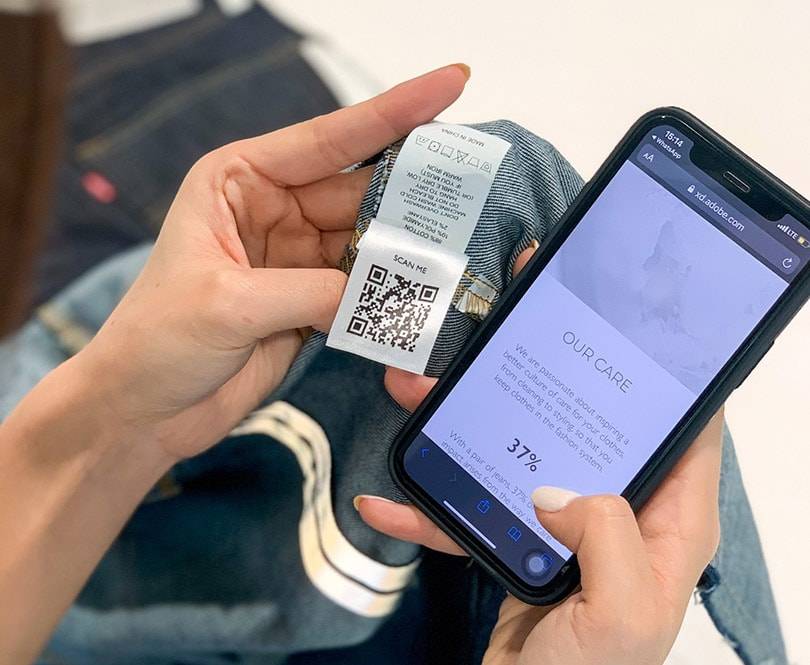Product passports. Talent deficiency. Cyber-resilience

The fashion industry is set for a significant structural rework in every sense in 2022. From more transparency to workplace diversity, there isn’t a foreseeable change coming that won’t positively affect how we operate. Ready or not, a wild whirlwind is ahead, but companies that endure will reap the lasting benefits.
Product Passports
Product passports are digital records that store and share product information and sustainability credentials. Their aim is to boost brand-consumer transparency and authenticity while tackling a major circular fashion road block – product identification. Product passports are a vehicle for significant industry improvement but will not come without challenges.
These passport technologies link consumers and partners to valuable information on individual products via a combination of blockchain centred technologies. A process supported by radio frequency identification (RFID), QR codes and near-field communication (NFC). The data held on a product passport will include material origin and manufacturing information—altogether helping to increase brand transparency, legitimacy, and sustainability.

Product Passport Benefits: Transparency
Never has the demand for a product and business transparency been so high. Many consumers now choose to shop only with brands taking concrete actions towards climate change and improving ethical practices. Brands are currently being held accountable for their actions and need to gain the trust of young consumers who are actively seeking out brands with a good reputation for sustainability. Often, consumers remove labels from their garments which compromises a brands efforts to be transparent. This separation of information and garment results in a lack of product information for the consumer. It goes on to put a spanner in the circular fashion process. A product passport helps avoid this issue by providing associates with unaffectable digital data. This way, a product is never separated from its information, helping facilitate more accessible collection and sorting of garments for recycling at scale.
Product passport benefits: Authenticity
Fashion resale will skyrocket this year, making the need for product authenticity proof and track history essential, particularly in luxury. Passport technologies will help streamline operational procedures by providing accessible digital twins and standardised product information to support confirmation and valuation. Chanel is ahead of the curb, launching a digital passport to replace traditional physical authenticity cards in its bags. The new passport will be accessible via a scannable metal plate in the product.
The Challenge
Fashion businesses have invested in digital technologies that allow unique identifiers and other data to be added to products. But to ensure ROI, companies must come together on common standards and engage with pilot projects at scale. Pressure for supply chain transparency and adoption of circular business models will be a make or break for brands that struggle to adapt. Per Business of Fashion, Timothy Iwata-Durie says,
“It’s really important that there’s been a democratic process so we could create a governance structure and a standard that works for both smaller brands and big brands,” explains Iwata-Durie, Cartier’s global innovation director and a member of the Aura board.
So how will smaller brands keep up with industry standards and innovations? The price of an RFID (radio-frequency identification) tag has historically been of higher value. Still, it has come down significantly in recent times- falling 80 per cent over the past decade. A result of its gradual rise in demand and scaling. Passport technologies will strengthen consumer trust, build exclusivity, support repurchase, and allow more sustainable and responsible practices for successful adopters.
Cyber Resilience
As we continue to take more steps towards the digitalisation of the fashion business, we face new and heightened challenges in cyber security. The threat of cyber-attacks is more significant than ever before, as is the risk of improper data handling. Fashion leaders must build resilience against cyber-attacks to protect their e-commerce growth in 2022. But digital risks related to sales are not just restricted to e-commerce. Premises with virtual fitting rooms, in-store tablets, and customer apps are also susceptible to cyber-attacks, leading to operational failures.
Another criticality for fashion businesses is in customer data collection and handling. Personalisation for consumer experience and greater market insight have become increasingly necessary for companies when considering future movements. This, whilst beneficially, increases the risk of improper data handling and exposes companies to external threats. These risks surface when companies share data with third parties in different legal jurisdictions. Meaning they are subject to separate privacy and data laws.

Why Now?
Cybercrime is becoming increasingly sophisticated and is now a common disturbance. This phenomenon is partly due to the acceleration of e-commerce and the consumers growing willingness to hand over their data to businesses in the process. Coinciding the recent growth in online shopping is a record of cyber-attacks worldwide. Stefan Larsson, chief executive of PVH Corporation says,
“Whatever cyber protection you had last year, last quarter, last month, yesterday, it’s not going to be enough for tomorrow,”
Credit: Mckinsey
According to Lance Spitzner, Senior instructor at the US-based SANS Institute, there are two reasons why cyber security is getting worse. “It’s becoming more and more profitable, so cybercriminals are going to follow the money…. [and they] are getting much better at it, too. It’s become an entire industry now [with] the cybercriminal community specialising in different fields”.
In response to these inevitable and growing threats, fashion leaders must boost their defences in cyber security. Companies should allocate a greater portion of their budget to such resilience. Companies must adopt a risk-based approach by elevating internal knowledge and resources whilst considering external cyber security firms for support.
Cyber security for all
Cyber security measures don’t come cheap and is a significant investment, particularly for SME’s and companies with fewer resources. Spitzner advises these companies to focus on the basics. “If you don’t know where to start, start improving your defences in phishing and passwords,” Spitzner tells Business of Fashion.
Talent Deficiency
As we all know too well, the climate we work in has shifted. Many people would argue that this shift has been for the better. Workplaces have had to adapt to a more flexible working environment, giving people a fresh perspective on work/life balance. Subsequently, people are refraining from returning to old ways of working and are quitting to find work elsewhere if they cannot maintain their new lifestyle. In conjunction with other contributing factors, this reason will lead to a talent deficiency in the year ahead.
Contributing factors
Compared to other industries, fashion’s employment practices are far behind. Other sectors work hard to build a desirable, supportive, and equal opportunity workplace. At the same time, fashion companies have relied on brand allure. Historically employers have gotten away with the “too big to fail” mindset. Thinking employees are “lucky enough to be here”, according to Caroline Pill, Global Fashion Lead at Kirk Palmer Associates.

Current employees in the industry are now beginning to realise this gap. They are also declaring concern for the industry’s environmental and social impact. Other issues include a lack of diversity, equity, and inclusion. Fashion brands must now get rid of subpar employment tactics to offer employees a flexible, supportive, and diverse work environment.
Fashion brands need to start listening to future talent moving forward. The next generation wants to be a part of the companies that account for their social and environmental actions. A demand needs to be met to focus on flexibility and staff well-being, and offer diverse, equal opportunities. Not the current standards.
Subscribe to FIB’s Weekly Alchemy Report for your weekly dose of music, fashion and pop culture news!






